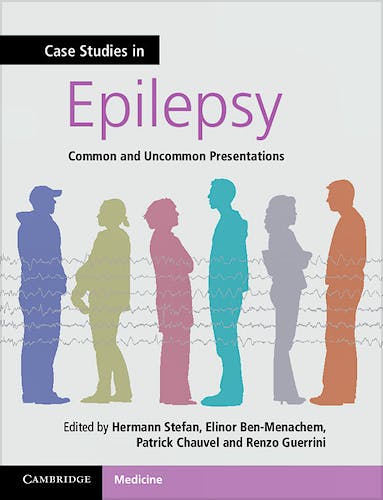

No hay productos en el carrito



Case Studies in Epilepsy. Common and Uncommon Presentations
Stefan, H. — Ben-Menachem, E. — Chauvel, P. — Guerrini, R.
1ª Edición Noviembre 2012
Inglés
201 pags
420 gr
17 x 25 x null cm
ISBN 9780521167123
Editorial CAMBRIDGE
LIBRO IMPRESO
-5%
64,17 €60,96 €IVA incluido
61,70 €58,62 €IVA no incluido
Recíbelo en un plazo de
2 - 3 semanas
LIBRO ELECTRÓNICO
-5%
58,25 €55,34 €IVA incluido
56,01 €53,21 €IVA no incluido
Acceso On Line
Inmediato
Description
Clinical case studies have long been recognized as a useful adjunct to problem-based learning and continuing professional development. They emphasize the need for clinical reasoning, integrative thinking, problem-solving, communication, teamwork and self-directed learning – all desirable generic skills for health care professionals. Epilepsy is amongst the most frequently encountered of neurological disorders. There are important emerging clinical management issues (e.g., first seizure, therapy-resistant seizures, ICU, pregnancy) but also differential diagnosis of non-epileptic seizures (syncopy, pseudo-seizure, paroxysmal dystonic syndromes, sleep disorders, psychosis, inborn errors of metabolism, etc.). This selection of epilepsy case studies will inform and challenge clinicians at all stages in their careers. Including both common and uncommon cases, Case Studies in Epilepsy reinforces the diagnostic skills and treatment decision-making processes necessary to treat epilepsy and other seizures confidently. Written by leading experts, the cases and discussions work through differential diagnoses, treatments and social consequences in pediatric and adult patients.
Features
- Includes recommended treatment plans which aid quick and accurate treatment of patients
- Case studies enable learning from real experiences
- Collects experiences from different European countries
Table of Contents
Preface
Part I. Diagnosis:
1. First seizure: is it epilepsy?
2. Intractable epilepsy and epilepsia partialis continua associated with respiratory
chain deficiency
3. Reasons for violent behaviour – when a man strangles his wife
4. Repetitive monocular eye adduction
5. Febrile infectious-related epilepsy syndrome (FIRES)
6. Epileptic seizures as presenting symptom of the Shaken Baby Syndrome
7. Benign rolandic epilepsy
8. New onset focal and generalized epilepsy in an elderly patient
9. When laughing makes the child fall down
10. Epileptic spasms and abnormal neuronal migration
11. A feeling of gooseflesh
12. Generalized epilepsy in adolescence as initial manifestation of Lafora disease
13. Epilepsy with a right temporal hyperintense lesion in MRI
14. Epileptic falling seizures associated with seizure-induced cardiac asystole
in drug-resistant temporal lobe epilepsy
15. Seizures, dementia and stroke?
16. Comorbidity in epilepsy – dual pathology resulting in simple focal,
complex focal and tonic clonic seizures
17. Minor motor events
18. Epilepsy in the ring chromosome 20
19. A late diagnosis of medial temporal lobe epilepsy
20. Experimental phenomena in temporal lobe epilepsy
21. The use of depth EEG (SEEG) recordings in a case of frontal lobe epilepsy
22. A frontal lobe epilepsy surgery based on totally non-invasive investigations
23. A young man with reading-induced seizure
24. The lady from 'no-man's-land'
25. The man who came (too) late
26. Paraneoplastic limbic encephalitis
27. Really a cerebrovascular story?
28. Sudden unexpected death in epilepsy – the ultimate failure
29. Blind but able to see
30. Seizure disorder! Really unexpected?
31. Transient epileptic amnesia in late onset epilepsy
32. A really unexpected injury?
33. Epileptic negative myoclonus in benign rolandic epilepsy
34. Sporadic hemiplegic migraine
35. A strange symptom: psychotic or ictal?
36. Hearing voices: focal epilepsy guides diagnosis of genetic disease
37. Life threatening status epilepticus due to focal cortical dysplasia
38. Childhood occipital idiopathic epilepsy
Part II. Treatment:
39. Unconscious: never again work above a meter?
40. A patient's patience
41. Idiopathic absence epilepsy: unusual AED consumption successful
42. Woman with gastric reflux – careful with combinations of medications
43. An example of both pharmacodynamic and pharmacokinetic interactions
44. Never give up trying to find the right medication even in patients who are
refractory
45. Juvenile myoclonic epilepsy and seizure aggravation
46. Episodic aphasia – surgery or not?
47. Temporal lobe epilepsy: drugs or surgery?
48. Shaking in elderly: reversible or fate?
49. Failure of surgical treatment in a typical medial temporal lobe epilepsy
50. Cutaneous adverse reactions by AEDs: chance or predetermination?
51. Timing of medical and surgical treatment of epilepsy: a hemispherotomy that
would have prevented disabling cerebellar atrophy
52. Anticonvulsive drugs for gate disturbance and slurred speech?
53. Unsuccessful surgery: another chance?
54. If it's not broken, don't fix it!
55. Never ever give up
56. Hippocampal deep brain stimulation may be an alternative for resective surgery
in medically refractory temporal lobe epilepsy
57. Myoclonic seizures and recurrent nonconvulsive status epilepticus in Dravet
syndrome
58. Functional hemispherotomy for drug-resistant post-traumatic epilepsy
59. Pharmo-resistent epilepsy?
60. Vagus nerve stimulation for epilepsy
61. The strange behaviour of a vegetarian: a diagnostic indicator for treatment?
Index.
· Edited by: Hermann Stefan, Friedrich-Alexander-Universität Erlangen-Nürnberg,
Germany
· Edited by: Elinor Ben-Menachem, Göteborgs Universitet, Sweden
· Edited by: Patrick Chauvel, Université de la Méditerranée,
Aix Marseille II
· Edited by: Renzo Guerrini, Director - Pediatric Neurology Unit and
Laboratories, Children's Hospital A. Meyer-University of Florence
© 2026 Axón Librería S.L.
2.149.0